Archives
-
Goodbye 2009
I wish everybody out there health, success and overall happiness in 2010.
-
Bonn: Vortrag über “Dynamic Languages” aus erster Hand
Sehr kurzfristig hat sich die Gelegenheit ergeben, Harry Pierson, Program Manager bei Microsoft im IronPython Team, für einen Vortrag nach Bonn zu holen – da sagt man natürlich nicht Nein, wenn man die Chance hat.
Am 17.11.2009 um 19:00 (Einlass ab 18:30) wird Harry über dynamische Sprachen im Microsoft .NET Umfeld sprechen:
As you may know, Microsoft is developing IronPython and IronRuby, .NET implementations of the popular open-source programming languages Python and Ruby. While it's clear that Microsoft wants to attract existing Python and Ruby developers to .NET, the role of IronPython and IronRuby for existing .NET developers is less clear. What value is there for a .NET developer in learning IronPython? What are the tradeoffs between IronRuby and a more traditional .NET language like Microsoft Visual C# or Visual Basic? Harry Pierson, new PM for IronPython, discusses where dynamic languages fit in the.NET developer's toolbox.
Veranstaltungsort sind die Räume der Comma Soft AG, nur wenige Minuten von der A59 Ausfahrt Pützchen entfernt (Anfahrtsbeschreibung). Dort finden auch regelmäßig die Treffen der Bonner .NET User Group “Bonn-to-Code.Net” statt, das nächste übrigens bereits eine Woche später.
-
.NET Open Space 2009 in Leipzig – Ich war dabei!
Es ist eine Sache, ob man von anderen Leuten erzählt bekommt, dass ein bestimmtes Konzept funktioniert. Es ist eine ganz andere Sache, wenn man es tatsächlich erlebt.
So geschehen beim .NET Open Space 2009 in Leipzig an diesem Wochenende. Ich hatte zwar die Berichte über den Erfolg der letztjährigen Veranstaltung im Hinterkopf, eine gewisse Skepsis konnte ich mir trotzdem nicht verkneifen, wie denn ein “Open Space” in der Praxis aussehen würde.
Würde es funktionieren, wenn ein Haufen Entwickler morgens zusammensteht, sich auf die Sessions des Tages einigt und dann einfach loslegt? Nach dem Wochenende lautet die Antwort ganz klar: JA!
Ein kleiner, aber feiner Punkt dabei war, dass die Vorschläge für Sessions nicht unbedingt in der Form “Ich beschäftige mich mit Thema X, darüber könnte ich etwas erzählen” sein mussten – erlaubt waren auch Themenwünsche. So entstammten im Endeffekt nicht wenige Vorschläge der Frage “Wie geht Ihr eigentlich mit dem Thema Y um?”. Die Diskussionen waren insgesamt sehr interessant und selbst wenn man irgendwo am Anfang dachte “ok, das gibt nichts mehr”, ergaben sich plötzlich wertvolle Gespräche.
Ich selbst hatte zwei Themen (auch eher als Frage) vorgeschlagen:
- WPF/Silverlight GUIs für Business-Anwendungen
Das Thema dümpelte mit durchaus interessanten, aber recht allgemeinen Betrachtungen vor sich hin, bis plötzlich Lothar Grieb und ein Kollege ein Notebook mit einer Silverlight Business-Anwendung aus der Tasche zog, die im Laufe des Wochenendes durch eine ganze Reihe Details noch mehrfach für offene Münder sorgte.
- WPF/Silverlight Performance
Mit einer Reihe erfahrener WPF/Silverlight besetzt, war dies die Session bei der ich am meisten gerlernt habe. Der Arbeitsbereich User Interfaces und User Experience enthält eine Zusammenstellung von Links zum Thema.
Die zwei Tage waren im Nu vorbei; was mir aufgefallen ist, dass innerhalb der jeweils einstündigen Sessions gar nicht die übliche “Konferenzmüdigkeit” zwischen Minute 30 und 50 eintrat, dafür war man viel zu involviert.
Ich bin jedenfalls jetzt vom Konzept endgültig überzeugt. Und die Umsetzung (Veranstaltungort, Orga, Essen, Drumherum) war einfach Klasse, herzlichen Dank dafür an Torsten Weber, Alexander Groß, Stefan Lieser und Marcel Hoyer sowie weitere fleißige Helfer im Hintergrund.
Wenn es sich zeitlich einrichten lässt, bin ich nächstes Jahr wieder dabei!
- WPF/Silverlight GUIs für Business-Anwendungen
-
How to avoid flicker when resuming video playback inside MediaElement
I just fought with some noticeable flicker during the first few frames when resuming a paused video inside a WPF MediaElement. It turned out that setting the ScrubbingEnabled property to “True” fixed the problem.
(Posted just in case somebody else is searching the web for the same problem)
-
.NET Open Space 2009 in Leipzig – Ich bin dabei!
Am 17./18.10.2009 findet in Leipzig der .NET Open Space 2009 statt. Dabei handelt es sich um eine “Unkonferenz”, also eine Veranstaltung, bei der es keine feste Rollenaufteilung Sprecher / Zuhörer wie bei traditionellen Entwicklerkonferenzen gibt.
Kann so etwas funktionieren? Die positiven Erfahrungen des ersten .NET Open Space 2008 in Leipzig und des Ablegers .NET Open Space Süd 2009 in Ulm zeigen eindeutig: Ja!
Anmeldung und weitere Infos auf http://netopenspace.de/
Nachdem es letztes Jahr bei mir nicht geklappt hat, werde ich dieses Jahr auch in Leipzig sein und mich dort wohl viel im Arbeitsbereich User Interfaces und User Experience herumtreiben.
-
Upgrading from “Weigelt” GhostDoc to “SubMain” GhostDoc
As I wrote in an update to my “The Future of GhostDoc” blog post, the uninstaller of GhostDoc 2.1.3 contains a bug which (under specific circumstances) may lead to losing your Visual Studio settings – I’m really sorry about that.
In the days after the first SubMain release in May (version 2.5.09150) I have helped the guys from SubMain in developing a working uninstaller for old GhostDoc versions, which is now included in the setup of the current GhostDoc version 2.5.09166 (published mid-June, though the website has been only updated recently).
So the “right way” to upgrade from an old “Weigelt” GhostDoc version (up to 2.1.3) to a new “SubMain” GhostDoc version (starting with 2.5.09166) is:
- DO NOT uninstall Weigelt GhostDoc
- Just run the SubMain GhostDoc setup
Everything else will be taken care of. Future updates (from one version of SubMain GhostDoc to another) also involve just running the installer of the new version.
-
The Future of GhostDoc
Today is the day that I'm finally able to speak about why things have been pretty quiet lately regarding the future of GhostDoc.
I'm happy to announce GhostDoc has been acquired by SubMain, developer of tools like CodeIt.Right. The agreement covers the usage of GhostDoc's documentation generation technology in their products, as well as the availability of GhostDoc as a standalone product. SubMain will continue to maintain and distribute a non-crippled version of GhostDoc free of charge, and will make sure that it will work with future versions of Visual Studio like the upcoming VS2010. The first step is a new version 2.5 of GhostDoc that has been released just moments ago.
For more information please take a look at a Q&A with Serge Baranovsky from SubMain and me that covers past, present and future of GhostDoc.
As I already mentioned in the Q&A, from my experiences of working with the guys at SubMain (both on the legal and the technical stuff), I can say that GhostDoc is in good hands. The developers now have my issue tracking database where I collected and annotated all the feature requests of the recent years, but I also would like to ask every GhostDoc user to please let them know if you have ideas how to improve this tool.
I'd like to use this opportunity to say a big Thank You to all GhostDoc users out their for their (overwhelmingly positive) feedback over the recent years. Thank You!
Update: Important note for existing GhostDoc users
There are uninstall issues with the old GhostDoc version 2.1.3 (and versions before) that under specific circumstances may lead to losing your Visual Studio settingson Vista machines. I'm already working on a solution to the problem (with help from one of the SubMain developers), in the meantime please back up your settings as described inthis step-by-step guidebefore uninstalling the old GhostDoc version. During uninstallation, if a Visual Studio instance pops up and asks you to choose a developer profile, choose one and continue. This will lead to the loss of the settings, which then can be restored by importing the backup you just made before. Note that you have to choose a profile; cancelling the dialog will lead to a corrupted state of the uninstallation.The new GhostDoc from SubMain is using different install/uninstall/VS integration technology that has been proven in their other products and does not have such problems.
Update 2: Please read this blog post on upgrading to GhostDoc 2.5 and later.
-
Meine Top-3 Entwicklertools
Die Chance, eine XBox zu gewinnen, lasse ich mir natürlich nicht entgehen, daher hier meine persönliche Top-3 Liste der Entwicklertools:
- JetBrains ReSharper hat es mit gewissen Anlaufschwierigkeiten (Tests von früheren Versionen hinterließen bei mir z.T. einen zwiespältigen Eindruck) nun in der Version 4.5 auf Anhieb in die Top-3 geschafft.
- .NET Reflector braucht man einfach immer wieder, sollte daher auf jeder Entwickler-Maschine installiert sein.
- SonicFileFinder dient zum schnellen Suchen von Dateien in Visual Studio und schlägt dabei die in ReSharper eingebaute Funktionalität.
Erwähnenswert ist natürlich Visual Studio, das aber nicht in der Top-3 Liste ist, weil man es für Entwickler eigentlich schon zum Betriebssystem zählen kann ;-)
- JetBrains ReSharper hat es mit gewissen Anlaufschwierigkeiten (Tests von früheren Versionen hinterließen bei mir z.T. einen zwiespältigen Eindruck) nun in der Version 4.5 auf Anhieb in die Top-3 geschafft.
-
Das war die dotnet Cologne 2009
Ein erstaunlich reibungsloser Ablauf, sehr positives Feedback von Teilnehmern, Sprechern und Sponsoren – alles in allem war die dotnet Cologne 2009, eine Community-Konferenz für WPF und Silverlight, für mich als Co-Organisator zwar eine anstrengende, aber auch sehr befriedigende Angelegenheit.
Die Konferenz war eine Gemeinschaftsproduktion der von Albert Weinert geleiteten .net user group Köln und der von mir geleiteten Bonner Gruppe Bonn-to-Code.Net, die im Januar zu diesem Zweck den dotnet Köln/Bonn e.V. gegründet hatten, mit Stefan Lange als erstem Vorsitzenden. An dieser Stelle sei auch die Mithilfe von Stefan Lieser und Jan Welker sowie unserer Helfer vor Ort (Janine Gollub, Carla Hein und Alberts Vater) erwähnt. Ein großer Dank gilt natürlich unseren Sprechern und Sponsoren, nicht zuletzt Microsoft mit großartiger Unterstützung. Ein ganzer Tag mit zwei Tracks, 11 Sessions, Freigetränken und einem umfangreichen Mittagessen für nur 15,- Euro wäre ohne sie nicht möglich gewesen.
Es war nur ein wenig schade, dass wir frühzeitig Opfer unseres Erfolgs wurden und für die Anmeldung rund einen Monat vor dem Termin eine Warteliste einrichten mussten. So mussten wir leider vielen Interessenten absagen und für die 160 Teilnehmer vor Ort wurde es hier und da stellenweise etwas “kuschelig”.
Für das nächste Jahr – eine dotnet Cologne 2010 ist bereits fest ins Auge gefasst – werden wir in Bezug auf die Räumlichkeiten unsere Möglichkeiten ausloten, wobei der diesjährige Ort (die Microsoft-Niederlassung am Kölner Rheinufer) in vielerlei Hinsicht schon sehr attraktiv war.
Hier noch ein paar Impressionen:
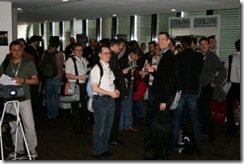
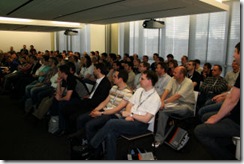
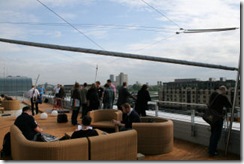
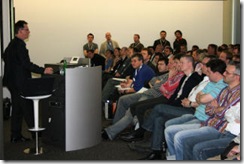
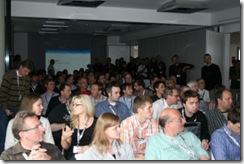
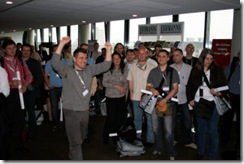
-
Oh No: Windows 7 Start Menu Search Still Different From Vista’s
Edit 2009-05-02: After a bit more fiddling around, things look a bit different now. Edits are inline and at the bottom of this post.
When I tried the Beta of Windows 7 a few months ago, the changed behavior of the Start Menu Search caught my eye immediately:
- Imagine you just installed Paint.NET on your machine
- You press the Windows key, and start typing “paint”.
- The start menu will present you “Paint” (for the Paint.exe that comes with Windows) and “Paint.NET”.
- In Vista, if you choose Paint.NET and start it, the next time you press the Windows key and type “paint”, the entry “Paint.NET” will be at the top. A nice feature, that even my dad picked up immediately. In his case the paint program he wants to start is “Corel Paint Shop Pro”. He doesn’t care about the company name or the exact name of the program – it’s the “paint thingy” he wants to start, and Windows key, “paint”, Enter does the job.
- Windows 7 knows better, though.
Search results are always shown in the same order(Edit: things are a bit more complicated than that. search results are in fact handled like in Vista with the exception of shortcuts pointing to Windows programs. These are always shown at the top of the results. That’s why Paint.Net couldn’t move up in the result list). Maybe it’s about consistency and avoiding mistakes by people who don’t look at the result list before they press Enter. But frankly I don’t care. Giving me a wonderful feature in Windows Vista and taking it away in Windows 7 is plain cruel.
I posted a feedback (see note regarding the link) to the Connect website regarding this, but didn’t get any reaction from Microsoft (not surprising, considering the amount of feedback they must have gotten).
Now I’ve just installed Windows 7 RC and unfortunately the behavior still is different from Vista. So if there isn’t some setting which I didn’t see at first glance to restore the old behavior, if the code was even ripped out or disabled completely, then chances are pretty slim to see the Vista behavior back again (it’s an RC after all). This is so frustrating. Please somebody tell me that there’s a registry hack…
______
Edit 2009-05-01: It may be that you have to be a member of the Connect program to be able to view the feedback when clicking the link.______
Edit 2009-05-02: I’ve now experimented some more with the Start Menu Search. I created 4 shortcuts in the start menu named “Company Product (A)”, “Company Product (B)”, “Company Product (C)” and “Company Product (D)”, with the last pointing to “C:\Windows\Notepad.exe” (the others pointing to programs somewhere below “C:\Program Files”).After typing “product” in the search box, the default order of the entries was D, A, B, C. Entry D took first place because it pointed to Notepad.exe, a Windows program.
Then I started the program with the shortcut ““Company Product (C)” a couple of times and the resulting order of the entries was D, C, A, B. So entry C moved up, but couldn’t beat entry A.
Now comes the strange part: I created a shortcut named “Network” and typed “net” in the search box. The result: Paint.NET at the top of the list (from my previous experiments), then the shortcut I just created, followed by Windows’ “Connect to a Network Projector” and at last position “Network” (the Windows one). Strange. Next I typed “Network” in the search box, chose the Windows Network, and repeated this a couple of times. The result: My own “Network” shortcut still stayed at the top, the “Network” of Windows stayed at last position. There may be certain hidden logic behind this, but for a user it’s way too confusing.
-
ReSharper 4.5 – Yup, now I’m a fan
People around me have been huge ReSharper fans for quite a while, but it took me until ReSharper 4.1 to actually give it a try. So I played around with it, liked the features and – uninstalled it after a few weeks.
I can almost hear the uproar of ReSharper fans “how dare you? This is like going back to writing code with Notepad!”. But honestly, version 4.1 did get on my nerves. I was constantly reminded that I had ReSharper installed, unfortunately in a bad way. Visual Studio simply didn’t “feel right” anymore in terms of performance. One of the many things that nagged me was that starting a new instance of Visual Studio for opening a solution always took a considerable amount of time.
ReSharper 4.5 is a different story, though. Of course, certain features need a certain amount of CPU and I/O power, that’s a natural fact. Of course there’s still a slight delay here and there compared to a naked Visual Studio.
And when opening a solution by starting a new VS instance, ReSharper is “cheating” a little my making its features available only after a few seconds. But that’s perfectly fine with me – when I open a solution I usually need some time to look around a bit before doing actual work, time that ReSharper can use for initialization. That’s much better than making me wait until I can even decide whether I opened the right solution.
After a full day of coding on two C# solutions that with 4.1 installed made everything feel rather sluggish all in all, I can say that now with 4.5 installed I never thought about going back to a Visual Studio without ReSharper. And now that I’m not constantly thinking about performance, I finally can enjoy the many nice features of ReSharper.
Indeed, if you’re not a ReSharper user, now is a very good time to give it a try!
-
dotnet Cologne 2009 bald ausgebucht!
Wow, das ging schnell – da lässt man sich ein klein wenig Zeit mit dem Schreiben eines Blog-Eintrags um die Community Konferenz für WPF und Silverlight zu bewerben, und schon muss man sich sputen, damit er nicht überflüssig wird!
Die Veranstaltung findet am 15. Mai 2009 in der Microsoft-Niederlassung in Köln statt und wird von den .NET User Groups aus Köln und Bonn organisiert.
Hier kurz die Fakten:
- 1 Tag
- 2 Tracks
- 12 Sessions
- 15,- Euro (inkl. Verpflegung)
Und jetzt schnell anmelden, denn die Teilnehmerzahl geht stetig der durch das Platzangebot gesetzten Grenze von 170 Personen entgegen!
Aktuelle Infos auch auf Twitter unter http://www.twitter.com/dotnetCologne, das offizielle Hashtag ist #dnc09
-
BASTA! Spring 2009: Folien zu UX Guidelines online
Da das Interesse an den Folien zu meinem Vortrag über die Windows User Experience Guidelines nicht so recht abreißen will (und es wohl noch etwas dauern wird, bis die offizielle CD zur Konferenz an die Teilnehmer rausgeht), hier die Folien zum Download (PDF, ca. 2,2MB).
-
Sprecher für WPF/Silverlight Konferenz in Köln gesucht
Die .NET User Groups Bonn (Bonn-to-Code.Net) und Köln (.net user group Köln) veranstalten am 15. Mai 2009 in Köln in den Räumen der neuen Microsoft-Niederlassung ein gemeinsames Community Event zu den Themen WPF und Silverlight – die dotnet Cologne 2009.
Das Ziel ist, den Teilnehmern (ca. 150-200) zum Selbstkostenpreis einen ganzen Tag mit praxisnahen Vorträgen (verteilt auf zwei Tracks) inkl. Verpflegung und einer abschließender Verlosung von Sachpreisen zu bieten.
Dafür suchen wir noch Sprecher, die dem Publikum zeigen, dass WPF und Silverlight mehr sind als nette Spielereien. Die zeigen, wie aus technischen Features konkreter Mehrwert in echten Anwendungen in richtigen Projekten wird.
Bis zum 8. März 2009 läuft der "Call for Papers", bei dem Vorschläge für Vorträge bei der dotnet Cologne 2009 eingereicht werden. Die Länge einer Session (Vortrag plus Fragen) beträgt 60 Minuten.
Bitte schickt Eure Vorschläge mit
- Titel des Vortrags
- Abstract
- Kurzbiographie
- E-Mail Adresse
- optional: Website/Blog
an orga [at] dotnet-cologne.de.
Die Veranstaltung ist als Event von der Community für die Community so kalkuliert, dass wir leider keine Honorare für Sprecher zahlen können, allerdings übernehmen wir gerne für Sprecher mit einer etwas weiteren Anreise (und ggf. Übernachtung) die Reisekosten bis zu einer Höhe von 200,- Euro.
-
Thoughts on Three Monitors for Developers
For developers, using two monitors almost has become mainstream. Modern video cards tend to have two outputs, a second monitor usually is available after upgrading to a larger screen, and most software - including operating systems - doesn't have any major problems working with multiple displays. And it's pretty safe to say that the majority of developers who have experienced the productivity gain of a two-monitor system (when used properly) don't want to go back.
The next question obviously is whether - and how much - a third monitor would help. I have two 24" TFTs both at work and at home and I'm using an additional display (my old 19" TFT) at home for a couple of months now. After spending three weeks on vacation at home and having finished the second week back at work I thought that now is a good time to compare the two setups and share my experiences.
How do I hook up a third monitor anyway?
Those of you who are interested in a third monitor may already have read about the problems with adding a second PCIe video card to your system - some combinations work, others don't. If you're like me and want an easy, low-risk solution, you should take a look at an USB graphics adapter.
I chose an EVGA UV Plus+ UV16 that has a DVI port and a chipset by DisplayLink for which 64bit Vista drivers are available. It may not be suitable for hardcore gaming, and HD resolution videos show a slight stutter if you're looking closely. But Aero and applications are working just fine. If you watch e.g. the rotation of the chess board in Chess Titans, you couldn't tell that you're watching it on a display connected via USB.
Regarding compatibility, I have to switch off the UV16 graphics adapter for running Flight Simulator X (switching off/on is easy via a tray icon), but I don't have problems with other games I've tried: Prince of Persia, Mass Effect and L4D run happily on my primary display (driven by a Geforce 8800 GTS 512). All in all I'm very happy with the UV16 and can recommend it.
Now, what is it like working with a third monitor?
To be honest, it takes some time to get used to. One thing I had to struggle with at first was caused by the position of the mouse. I'm right-handed and both at work and at home I have one 24" TFT right in front of me as my primary screen, and another 24" TFT as a secondary screen to the right, at an angle of about 40 degrees.
When I turn to the right, the secondary screen feels equally "near" to me as the primary screen. But when I turn to the left, towards the third screen, that screen feels more "distant" than the other two because I'm turning away from the mouse. This is strange at first, but in the end I got (kind of used) to it.
And what about productivity?
Don't expect a similar effect like when upgrading from one to two monitors. And it may happen that you don't develop a "couldn't live without three" feeling at all - after two weeks back at work with "just" two monitors, I know I don't. Sure it's nice to have more space for help files and web pages, but I have observed that I tend to
- either work with two instances of Visual Studio side-by-side (e.g. for moving over code step by step from a sample, or design time debugging),
or - do some research-heavy development in a single (visible) Visual Studio instance (with web pages and help files on the secondary display).
Well, what is it good for then at all?
For me personally, the primary reason for adding a third monitor was my hobby of working with video. I use the third screen as a preview device, and with the preview in Sony Vegas never running 100% in real time, I can't tell what is causing the occasional stutter anyway (USB adapter or video preview). Having the other screens available completely for the timeline and tool windows is great.
Another thing I like about a third monitor is that I have enough space for things like Twitter, Messenger, Skype. But this is at home, where I actually want to notice updates immediately and I'm open to distractions, contrary to the situation at work.
Having a third monitor dedicated to a remote desktop session or a virtual machine may be nice under certain circumstances, but with sufficiently large primary and secondary screens, I haven't encountered situations where three screens would have been much better than two. Let's put it this way: it's not as if going multi-monitor would suddenly take away the feature of switching between windows...
So what do I recommend?
Here's my recommendation regarding multi-monitor systems:
- Before even thinking about three screens, make sure you have two large screens of equal size. Being able to move an application from the primary to the secondary screen without fiddling around with the layout inside the application window (think Visual Studio) is worth a lot.
- If you already have two large screens, a third monitor is standing around collecting dust and you have enough space on your desk - you definitely could do worse than spending your money on a USB graphics adapter.
- But if you have to actually buy a third monitor, then you really should think about how you want to use it. Unless money isn't an issue and you want to impress people (in this case make sure that your computer emits the typical sounds of computers from movies and TV ;-). But for everybody else, watch yourself at the computer - where is your focus, how long do you need a certain application, how often do you have to switch between windows, which information do you need to be able to view in parallel, etc. And then make a buying decision.
As you can guess, this is my completely personal opinion, not based on any scientific research, so as usual YMMV. If you have any questions, comments or suggestions, feel free to leave a comment. Do you agree? Or do you organize your work in a different way across monitors so that three monitors notably increase your productivity?
- either work with two instances of Visual Studio side-by-side (e.g. for moving over code step by step from a sample, or design time debugging),
